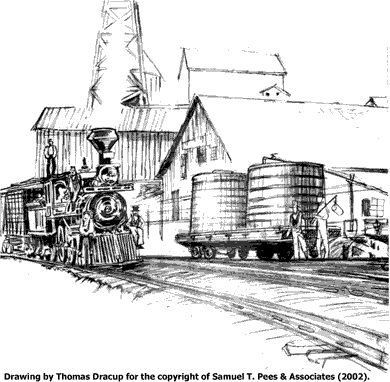 |
||||||
Wooden Tank Cars
The shippers and railway people called them tubs and thereby belittled the first railway tank car. They were not tubs, they were sturdy wooden tanks having a capacity of 40 barrels each and mounted two to a flat car, each one over the trucks. These tank cars were put into use on the tracks of the Oil Creek Railroad and connecting lines in 1865, a great year in the evolution of the bulk transportation of crude oil and refined products. Amos Densmore, an oil buyer and shipper at Miller Farm on Oil Creek is credited as being the inventor, so it is fitting that the conveyance was called the Densmore tank car.
The "prototype" tank car was subjected to an elaborate cloak and dagger test. A flat car with its two tanks filled with crude oil left theTitusville area ("secretly", they say) on a wild trip to New York. Telegrams were sent from each station back to Titusville and Miller Farm reporting on the condition of the tanks and especially if they leaked or not. Apparently they didn’t leak. Made of pine planks, the tanks were constructed, banded and glued as tightly as possible.
The Densmore model was then built by the thousands and became a common sight hitched to freight trains. Prof. Charles A. Seely in writing an article on the transportation of oil for the Scientific American magazine in 1866 remarked about the wooden Densmore tank cars carrying oil from Titusville: "---some of them may be seen any day in Jersey City, and on a journey by the Erie Railway they will be found everywhere along the road."
The Densmore tank car was a major breakthrough in the bulk transportation of oil and occurred just a couple of months before the completion of the first successful oil pipeline. In fact, much of the oil which that pipeline (Van Syckel) delivered from the Pithole field to the Miller Farm terminal was further carried to destination in these wooden tanks.
 |
Densmore tank cars on a siding in Oil Creek Valley, 1866. Drawing by Thomas Dracup for the copyright of Samuel T. Pees & Associates (2002). |
![]()
| © 2004, Samuel T. Pees all rights reserved |
|